Games
PCB
Archive
Chip
Archive
Cart/Box
Scans
Articles
Peripherals
Prototypes
Unreleased
Games
Rarities
Homebrew
Emulation
Links
Email: snes_central@yahoo.ca
Super Mario World 20th anniversarySuper Mario World 20th anniversary |
 Super Mario World was included with the Super NES at launch, and served as the best game for the fledgling console. In this article, I delve into this great game and the extensive SMW hacking community. By:
Evan G
|
November 21, 2010 marks the twentieth anniversary of the release of the Super Famicom, and its flagship title, Super Mario World. Since its release, Super Mario World has been widely regarded as one of the best games ever made. As a platformer, it allowed people to explore and find alternative routes to the end game, and introduced the friendly (and very hungry) green dinosaur, Yoshi. Though the game was not as flashy as fellow launch games, F-Zero and Pilotwings, this title is what initially drove sales of the fledgling system.
 |
| There have rarely been more iconic words written in a video game |
Super Mario World - Greatest Game Ever?
I remember well when I first played Super Mario World. It was Christmas Day, 1992. After much badgering (I'm sure) to my parents about how much better the Super NES would be, and how it was worth the upgrade from the NES, my brothers and I opened up this set of gaming goodness that morning. I'll tell you, for a 10 year old kid, nothing is more exciting than the newest video game console. We played the game a lot during the Christmas break, and I managed to pass the game six days after getting it. I even have a picture of myself, happy as can be, with the end screen (unfortunately, I don't have the access to the picture at the moment, so I can't post it). It was a few months before we got a new game, so you can bet that Super Mario World was definitely something I played to completion.
What makes Super Mario World so compelling? When you look at it in a graphical sense, it is simple, and hardly better than many of the contemporary Genesis games (such as Sonic The Hedgehog, which was released shortly before the launch of the SNES). The music is cheery and upbeat, though most of the songs are just remixed versions of the first level's song. The amount of forms Mario takes decreases from Super Mario Bros. 3. The "save the princess from Bowser" storyline is as cliched as the first Super Mario Bros. game. Gameplay trumps any other factor, and this is what makes Super Mario World stand out.
Graphics
Without a doubt, Super Mario World is a sharp upgrade in graphics from its earlier NES counterparts. The colours are vivid and bright. The backgrounds have parallax. The enemies are detailed and are not boxy looking. That said, the level objects, like platforms and bushes are rather plain by the standards of many subsequent SNES platformers. In a sense, it gave the game a cartoony look. The game also underutilized SNES specific scaling features, only displaying them during boss scenes. Also, the game has instances of slowdown, particularly noticeable after you finish a switch palace level. Slowdown is rare in actual gameplay, though. When compared to Sonic the Hedgehog, there is almost no difference in graphical quality. Sonic came out two months before the release of the SNES in the United States, and any wow factor that Nintendo may have relied on would have been diminished.
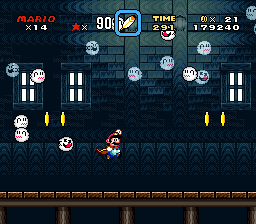 | 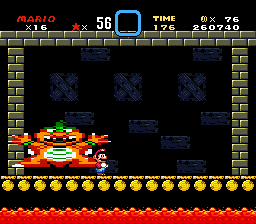 |
| Ghost house level, showing off a scene with a large amount of sprites with no slowdown | Sprite scaling when defeating Morton Koopa. |
Music and Sound
The music in Super Mario World is set up to be very appropriate for the levels. Simple platforming levels have a cheery, calypso theme. Levels that require more careful jumping have a more rapid pace in music. Underground levels have a frantic drum beat, while ghost house and castle levels have a more doomy soundtrack. Similarly, the sound effects are appropriate and well done. Key touches, like an echo sound when Mario jumps in underground level add to the mood of the game. Another neat effect is the addition of a drumline when you are riding Yoshi. The sound is catchy, memorable and served as a great example of the superiority of the Super NES sound chip.
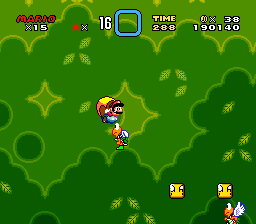 |
| Mario's cape tricks |
Gameplay
Gameplay is where Super Mario World really shines. While Super Mario Bros. 3 added a variety of special suits, most were underutilized. In Super Mario World, the focus is on Yoshi and the cape. Yoshi has various powerups based on what colour shell he eats, though certainly the ability to eat enemies in general and for Mario to get a jump boost of of him that really added to the gameplay. The cape allows Mario to fly, but unlike the raccoon suit in SMB3, you can continue to glide through an entire level if you are skilled enough. In essence, they reduced the amount of powerups that Mario has, but increased their flexibility.
What made Super Mario World stand out from its predecessors was the non-linearity. It is entirely possible to finish the game by playing only twelve levels. But the game gives you many branching paths, that allow you to explore and search for alternative routes. The optional levels give you a much more challenging way to Bowser's castle than the general default path.
The level design in Super Mario World ranges from linear (Yoshi's Island 1) to complex (Chocolate Island 2). In later levels, the secret exits can be a challenge to find, though the designers made sure to leave enough clues to make them attainable (for example, the signpost after the main exit in the Cheese Bridge). The game is balanced, and the most general way to reach Bowser (going through the Koopa Kids' castles) should be beatable by an average gamer. The bonus stages found after finding the secret exit to Star Road 5 provide an excellent challenge to extend the game.
Development
 |
| Sprite rip from the SNES Burn-In Test Cartridge |
According to an interview with Shigeru Miyamoto in the Mario Mania strategy guide, Super Mario World took three years to develop. Concepts like Mario riding a dinosaur were considered during the development of the NES games, though it was not technically possible to implement. Early in the development, the game was indeed going to be "Super Mario Bros. 4". It was referred to as such on the November 1990 issue of Electronic Gaming Monthly. In fact, the title is still on the Japanese cart.
Early screenshots from the September/October issue of Nintendo Power show that the graphics were similar to Super Mario Bros. 3. These screenshots come from a press conference Nintendo put on in July 1989 when they revealed the final specs for the Super Famicom. In fact, the Raccoon suit was present in early versions of the game. The recently dumped SNES Burn-In Test Cartridge has some early Super Mario World sprites within it, including the Raccoon Mario suit. The map screen also looks far less rigid than the final version. The January 1990 issue of Nintendo Power shows some screens from a nearly finished version of SMW (see below), which shows a different Banzai Bill sprite. The US version did not change much from the Japanese release, though they changed the Super Mario World text in the introduction so that it doesn't take up as much space. For an excellent overview of unused elements for Super Mario World, I recommend checking out the page on Super Mario Wiki.
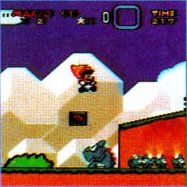 | 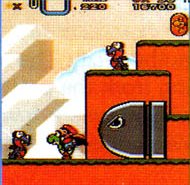 |
| Early screenshot of Chocolate Island 2 with lots of Dino-Torches | Early screenshot of Yoshi's Island 1 with a different Banzai Bill sprite (both shots from Nintendo Power, January 1990) |
Sonic vs. Mario in the 16 Bit era
The game should be compared with Sonic the Hedgehog. At the time, some people considered Sonic The Hedgehog to be just as good or better than Super Mario World. Being that this is SNES Central, I would have to disagree. Sonic the Hedgehog featured good graphics, but the gameplay is rather lacking in comparison. The game is linear, and though some levels have branching paths, in general the time limit dictates the amount of exploration you can do. Another factor is Sonic runs fast, and in many of the levels that can be to your detriment and lead to the feeling that you really aren't in control. In many levels, such as the Marble Zone, they don't even make use of Sonic's speed, instead favouring patient platforming. The momentum based motion of Sonic also frustrates me to a certain degree, making me long a button to hold down to run. The water based levels in Sonic The Hedgehog also make a mockery of the term "Sonic", and with no clear course laid out, death by drowning becomes a distinct threat. Sure, Mario not needing oxygen and having the ability to shoot fireballs underwater doesn't make any sense, but it is a heck of a lot more fun. I'm not saying that Sonic the Hedgehog is terrible, but I don't think it stands the test of time the way that Super Mario World does. Though when released, Sonic the Hedgehog gave Nintendo a run for their money, becoming the hot product for the 1991 Christmas season.
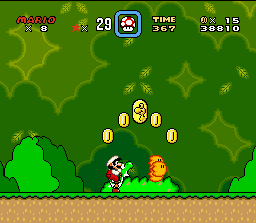 | 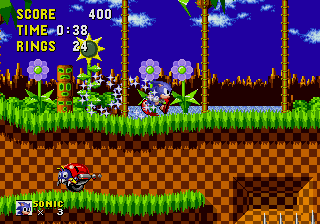 |
| Super Mario World | Sonic The Hedgehog |
The Super Mario World Cartoon
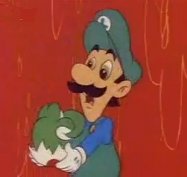 |
| Luigi finds Yoshi in the Super Mario World cartoon. |
Super Mario World was the subject of a short lived TV show in the United States. I honestly can't say I watched the show as a kid (didn't have cable), but the cartoon is remarkably faithful to the game, featuring music, sound effects and enemies from the actual game. Admittedly, the show is not that great (the animation is pretty bad), but does show the efforts to combine various forms of entertainment geared towards children. Though the run of the show was short (13 episodes), it remained in syndication for many years. It sort of marked the end of the dominance of Mario as the "Mickey Mouse" of the late 80s.
Reissues
Due to enduring popularity, Super Mario World has been re-released several times. The first was as a combo pack with Super Mario All-Stars, which served as a late stage pack-in for the Super NES in Europe and North America. The combo pack had some slight graphical changes, most notably for Luigi's sprite. Super Mario World was released as part of Nintendo's "Player's Choice" series. This is the most common boxed copy of the game for the SNES, with the box for the original game being fairly rare due to it being a pack-in. Super Mario World saw a port to the Game Boy Advance as "Super Mario World: Super Mario Advance 2". This version made slight changes to the level design (mainly to account for the different screen resolution, and the addition of dragon coins to all levels), allowed the option to use Luigi, who runs slower but jumps higher, the addition of saved scores and level completion stats, and added Super Mario 64 style voices. The game has also been released for the Wii Virtual Console. I don't have a Wii, but I have been told it uses the standard original release.
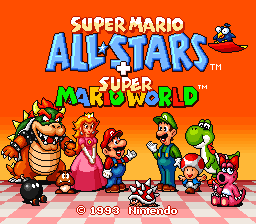 | 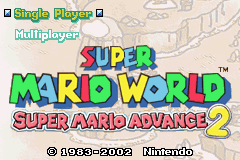 |
| Title screen for the Super Mario All-Stars + World compilation | Title screen for the GBA version |
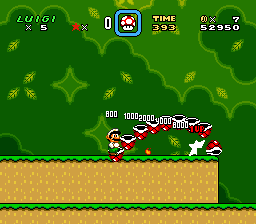 | 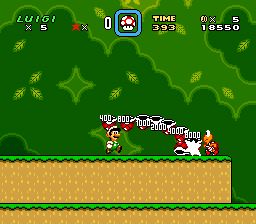 |
| Original release | Super Mario All-Stars + World compilation |
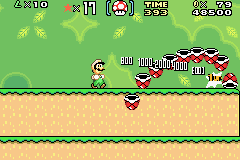 |
| Game Boy Advance |
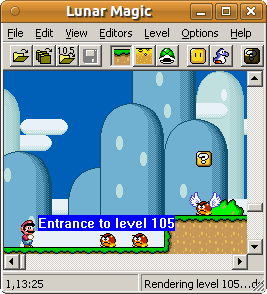 |
| The Lunar Magic editor |
Lunar Magic - Super Mario World hacking
About ten years ago, a ROM hacker who goes by the handle "FuSoYa" created a Super Mario World editor known as Lunar Magic. This unprecedented editor allows for easy creation of brand new levels for Super Mario World. Along with the many resources at SMW Central, it is possible to do a complete overhaul of the graphics and even add in new features to the game. I have to admit that even I have dabbled in SMW hacking. My attempts at SMW hacking were incredibly subpar (though I do enjoy what I did in the Yellow Switch Palace), though this was something I made some nine years ago when I was young and naive. I think even at the time, I questioned why Swampgas would even bother putting it on Zophar.net. I tried out a bunch of highly rated hacks for this article:
DDCecil's SMW hack is a simple hack with no changes to the overworld, and levels that are obviously based off the regular Super Mario World. The hack starts off strong with interesting level design, but by the Vanilla Done, there are some very poor design choices. For example, the secret exit in Vanilla Secret 1 is hidden behind the goal post, and I only found it by pure luck, flying high enough to go over (which is actually a bug). Butter Bridge 1 is also poorly designed, because the screen scrolls too quickly for the swinging platforms. Most of the levels don't give you enough time, leading to situations where you have to rush (for instance, the secret exit in the Donut Ghost House, where I passed the boss with a few seconds to spare, even with a well planned route).
The Second Reality Project 2 - Zycloboo's Challenge is a fairly good hack with lots of new graphics. It uses SMB3 music for some reason, and I don't think it fits with the mood of the hack. One issue is that the levels are very long, and the hack doesn't give you mercy by allowing you a save every level or so. The level design is ok, but it is not very forgiving and some of the incredibly long levels don't even have halfway gates. I got deep into the second set of worlds, but since I didn't feel like spamming a level to gain extra lives so that I could get a save, I moved on.
SMW2+3: The Essence Star is a nice looking hack, but I got to a level with music that sounded like an aircraft crashing into my house, and I couldn't stand it. I don't care much for these "story" oriented hacks as it is. The SMW game engine is not well suited to a story based game.
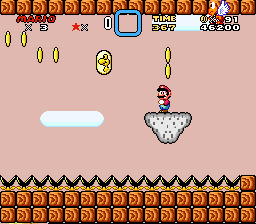 |
| Super Demo World - there is supposed to be a platform there on the left, but it went away. Also note the koopa going through a solid block. |
Super Demo World: The Legend Continues is one of the first full length SMW hacks, created by Lunar Magic author, FuSoYa. I played this years ago and remembered there were a lot of impossibly hard parts to it. I tried it again to get a feel for it. The first few levels were ok (though there were bad spots like a slide that goes straight into a pit in the third level). It really comes to a head in Desert World 2, where there are disappearing, glitching platforms, flying koopas that go through solid blocks, a pipe that send you straight into a piranha plant, a jump you pretty much can only achieve if you are small, and a narrow passage with a bunch of jumping green koopas that are very difficult to pass without getting hit.
Super Mario World: The Secret of the 7 Golden Statues is an interesting hack with lots of ASM modification. Though it adds some new gameplay aspects (like a wall jump and ground pound moves), this thing is a buggy mess. The author acknowledges that it only works in zsnes, which is basically telling me he was too lazy to do things properly. The first level (the game crashes after passing it) features a rather mediocre design, like the opaque tree canopy in the foreground in one section that makes jumps pretty dicey. Oh, and for some reason, the author thought it would be a great idea to allow piranha plants to come out even if you are standing on a pipe.
Super Mario World Hacks 101 v2.0 is a demonstration hack designed by people at SMW Central. I know this is supposed to be a demonstration hack, so I was expecting the strange level design. It uses custom music that glitches out almost instantly, and causes the game to randomly freeze.
 |
| Mario's Keytastrophe, showing major modifications to the map |
Mario's Keytastrophe v1.1 is one of the best Super Mario World hack I played. I have to say, this patch had some decent level design. Rather than side scrolling gameplay like the regular SMW, this hack is more puzzle based. The music is completely broken, and the game randomly crashes. The author suggests using zsnes 1.42 (1.51 came out well before this hack came out), which means he knew that this hack was broken and released it anyways. Disappointing.
Mario's Return Again is a simpler hack than most of the others. No custom music means no crashing. I got to the Big Boo boss in the second castle, which was pretty freaking hard. The purple grab blocks disappear too quickly for you to both scale these high gapped platforms and avoid the boo chains without getting hit. I gave up there. There were a few places in levels where you had to make blind leaps and enemy placement was a bit cheap at times, leading to death unless you timed things perfectly.
The Second Reality Project - Without a doubt this is the best Super Mario World hack I played. It doesn't add any fancy graphics, but it at least has good level design. That isn't to say it is perfect. There is one level (in the location of Vanilla Secret 2) that is impossible to pass without Yoshi. It took me about an hour to pass it because there are no Yoshi powerups in spots after where you are likely to lose him. I got onto the later levels, which were full of large gaps where you had to jump onto a single tile brick too often (for example the "Real Challenge" castle that is in the location of the Forest of Illusion castle, which I don't believe would be possible to beat without a cape feather). The fact that the patch author had to release an easier "SNES" version acknowledges the impossibility of some of the levels. Even in the easy version, the later levels are exercises in frustration, and once I got to Chocolate Island levels, I gave up. The "Reloaded" remake looks nice. For some reason, the author felt the need to prevent the player from keeping Yoshi between levels. Of course, it uses custom music, and has the tendency to crash.
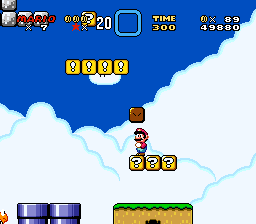 | 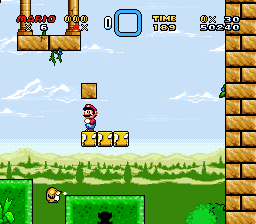 |
| The Second Reality Project | The Second Reality Project Reloaded |
On the whole, I have to same I was very disappointed in the Super Mario World hacks. It seems that people have taken inspiration from Super Kaizo World, an impossibly hard hack that can only be defeated using emulator tricks. The fact that every hack with custom music in it crashes when I play it on my SNES shows the lack of commitment to ensure that the hacks are compatible with hardware, exploiting bugs in old versions of SNES emulators (such as ZSNES). As emulators have become more accurate, these hacks become broken in them as well. Most Super Mario World hacks have some extremely difficult parts (mostly in the form of extremely difficult jumps or poor enemy placement). Some hacks have levels that can only be passed if you have a particular powerup (a rule of thumb is that all levels should have one exit that is accessible whether small, big, or with Yoshi). The emphasis on flashy graphics, sound and ASM hacks rather than solid level design stands in stark contrast to the philosophy of Super Mario World director, Shigeru Miyamoto. When I brought up these complaints to the SMW hacking community, I was met with apathy by all but a handful of people.
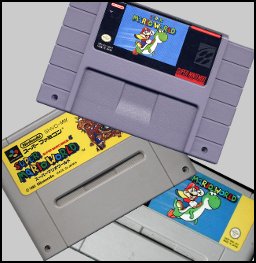
Summary
When I first decided to take a break from prototype articles (I still have many to write up after this), I decided there was nothing more important than bringing an overview of one of the best games ever created. The fact that it is the 20th anniversary of the initial Japanese release is purely coincidental. Before doing anything, I attained all 96 exits in the game (taking about 3 hours and 40 minutes), and it feels just as good now as it did back in 1992 when I first got the game. Throughout the history of the medium of video games, there are few standouts that stand the test of time. Super Mario World, along with the rest of the Mario series holds up with its focus on both exploration and reflex based gaming. Super Mario World expanded on the previous games in the series by adding new powerups and levels with multiple exits, plus allowing the player to decide their path to Bowser. It is an enduring classic that captivates gamers even twenty years later.